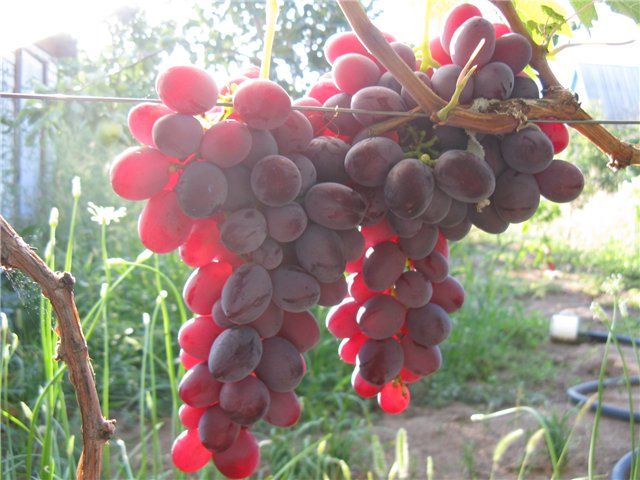
The quality of the future crop directly depends on the correctly selected grape variety for planting. Ruby Anniversary - a variety that is not whimsical to care for, and its bearing is plentiful. Large sweet berries, powerful brushes and a strong vine - such characteristics are given by gardeners in their reviews of the variety.
Content
Characterization and description of the variety
The bright berries of the Jubilee attract any passerby's attention. They ripen by the end of August, as the fruiting period takes 120-130 days. The shape of the fruit is round, weighty, the weight of one berry can easily reach 20 g. The skin color is combined: red-pink with yellow tints. The skin almost does not taste, because it is thin. To taste, the berry flesh is sweet, with an aftertaste of honey. The amount of sugar in the composition is 15-17 g, the acid content is 6-7 g / l. Due to the thin, but durable skin of the berries, they are well tolerated for transportation, so they are grown for sale. The Ruby Anniversary is used for fresh consumption, but the berries are suitable for the production of homemade wines and liquors. The hostess uses grape leaves for making dolma - they are durable and beautiful.
The bush is medium in height, its length rarely exceeds 5 m. From the moment of planting, the vine is tied to a support or to a trellis. Pruning is needed 1-2 times a year. The best yield is observed when no more than 30 eyes are present on the bush. Cut 6-8 eyes at a time. Grapes with grapes weighing about 700-800 g are gathered on the vines. Ripening is good, the berries are spiced at the same time. Mature shoots turn brown with dark green foliage. Flowering is fast in the summer. Flowers are hermaphrodites, therefore pollinators are not needed for fruiting.
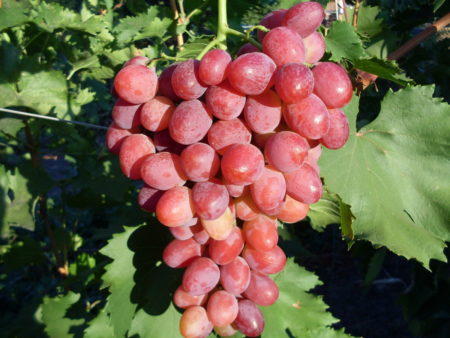
Ruby Jubilee has spread to the Crimean peninsula, in the Rostov region and the Krasnodar Territory. Less often it is grown in the Moscow region and the Leningrad region due to low frost resistance. Shoots are able to withstand frosts of up to -20 degrees, but they winter only in shelter. Rainy cloudy weather affects the quality of berries and the number of crops, so the Ruby Jubilee is grown mainly in the south of the country.
The variety is considered resistant to many grape diseases. Ruby Anniversary is weakly affected by mildew or oidium, not afraid of rot and other bacteria. Preventive treatment is needed, it is carried out 2 times a year: in spring and autumn. For processing, copper sulfate, Bordeaux liquid, or any fungicidal agents are used.
Ruby Anniversary has a number of positive qualities:
- large beautiful berries of unusual color;
- stable harvest;
- strong immune qualities;
- powerful shoots and abundant fruiting;
- unpretentiousness to the planting soil.
Among the shortcomings in the cultivation, it is noted that the variety attracts the attention of wasps. For protection, you need to provide a special shelter for grapes or purchase traps for insects. Birds sometimes attack berries, but they can be easily scared away with a fine net.
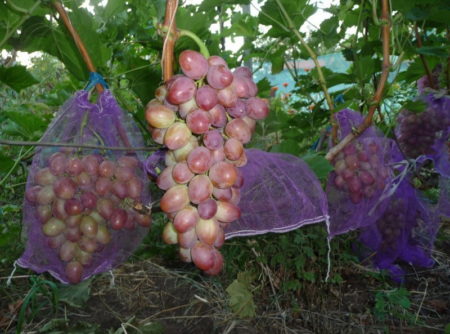
How to plant
The grape plot is best located on the south side or in the southwestern part. It is necessary to think over protection against wind, from the north side there can be, for example, a fence. Grapes are not grown near trees; the shadow zone is destructive for him. The groundwater level should be at least 1.5 m. The soil for the crop is laid in the fall or spring.Dig in the ground landing pits with a depth of 70-80 cm and with about the same diameter. First, a bucket of any drainage is poured into the hole, and then ½ kg of superphosphate, a humus bucket.
To planting a seedling start spring in early or mid-April. For a day, the seedling is soaked in a solution that stimulates the development and growth of rhizomes. Growth stimulator should consist of succinic acid, sodium humate, root. Such a nutritious mixture will give strength to the roots, and they will quickly adapt to a new place. The roots of the seedling are immersed in a hole with fertile soil and instilled, leaving the root neck outside. In the first 2 weeks of cultivation, seedlings are a little shaded.
How to care
In the first year of cultivation, the seedling is not often watered (1 time per month), the soil is loosened and treated with fungicidal preparations for diseases and pests. The first watering is carried out immediately after planting a seedling in a permanent place. After watering, the soil is loosened, if weeds appear, they are pulled out. When the first leaves begin to grow actively, the stem is freed from the earth layer. In June, a hole is made around the plant so that the surface roots get used to the surrounding temperature. If the roots are not tempered, then the plant will form slowly and listlessly. The hole is buried only in mid-August, when the street noticeably colder.
You can form a vine from the first year of cultivation. They leave the strongest and most powerful escape, and the rest cut off. Further pruning is carried out in the fall, after harvesting and in the spring. First of all, old, dried branches or weak shoots are removed. For pruning, you need a pruner or a sharp knife, breaking off branches is undesirable, you can damage the vine.
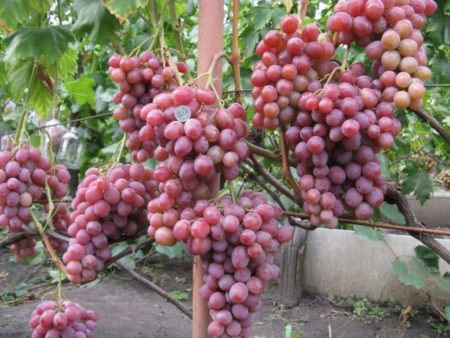
How to shelter for the winter
Ruby Anniversary needs shelter almost always. An exception is the southern regions with warm winters. Get ready for winter start in October. The vine is cut from the leaves, removed from the support. Near the place where they grow grapes, they dig a trench. Peat is laid in the trench, and shoots are lowered from above. The shoots are dug up with soil. A layer of cellophane or roofing material is placed on the garden bed. When the snow covers the ground, they bury it from above for shelter. In the spring, the snowdrift is removed, otherwise thawed snow will melt the soil.
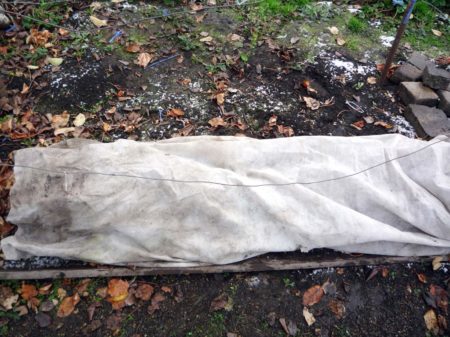
Reviews
Pavel from the Krasnodar Territory He speaks:
“The Ruby Anniversary attracted my attention with its beautiful berries. I grow it for 4 years in a row at the summer cottage. Fruiting occurs every year and is stable. Berries are always sweet and large, not prone to flickering. Since last year I began to use top dressing. He fed the grapes before and after flowering with a potash supplement (1 tablespoon per 10 liters of water). Fruiting began 2 weeks earlier than usual. ”
Anna from the Ivanovo region tells:
“I was worried that the seedlings would not take root in the ground due to the low frost resistance. Indeed, some plants died, but most remained. Planted grapes in April, in the middle of the month, but spring was late, it was cold at night. The remaining plants have bloomed, I hope that I will harvest soon. ”




 Non-covering winter-hardy grape varieties for Moscow region
Non-covering winter-hardy grape varieties for Moscow region How to keep the vine in winter
How to keep the vine in winter When can I transfer grapes to another place in the fall
When can I transfer grapes to another place in the fall How to cover and prepare grapes for the winter in the suburbs
How to cover and prepare grapes for the winter in the suburbs